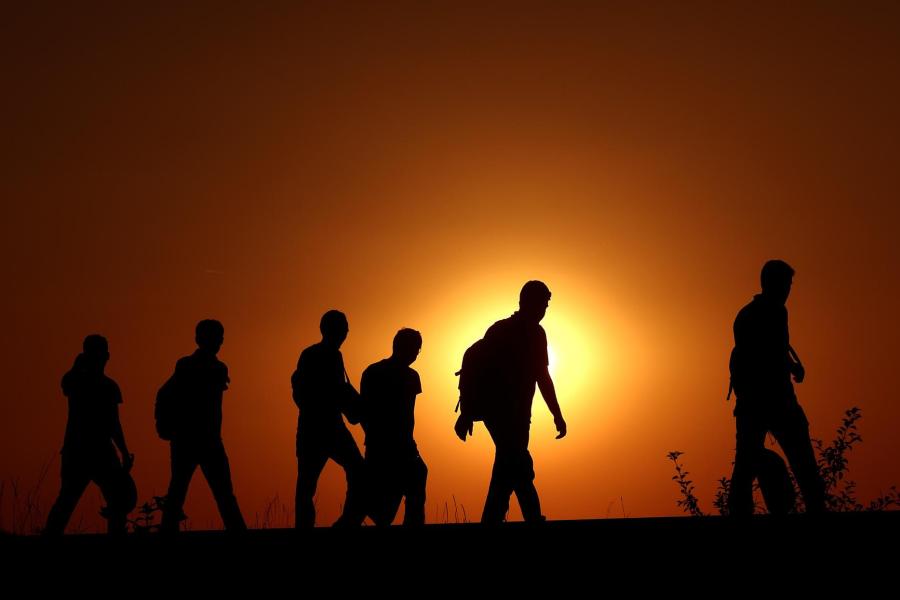Migration Governance within the African Continent

Prepared by the researche : Amr Rashad Ismail – Expert in African Affairs
DAC Democratic Arabic Center GmbH
Migration is a defining feature of Africa, as populations move in multiple ways both within and beyond the continent—through regular and irregular channels alike. Economic, political, climatic, and conflict-driven factors have increasingly pushed individuals to migrate, particularly since 2014. Africa has thus become a region of origin, transit, and destination for migrants. As the drivers of migration grow more complex, the challenges to good governance and the rule of law intensify. Managing migration is inherently multidimensional, given the diversity of migration patterns and the variation in national and regional policies. Fair and transparent migration governance promotes human dignity and upholds the rule of law, whereas policy gaps and ambiguities undermine legal justice. The governance frameworks for migration in Africa span several domains—mobility, trade, labor, protection from trafficking and smuggling, refugee issues, and climate change. Developing these frameworks in a comprehensive and equitable manner is therefore essential to ensuring the rule of law in a continent in constant motion.
This article aims to demystify the landscape of migration governance in Africa, where millions of people move within and beyond the continent due to poverty, conflict, climate change, and political instability. Despite existing legal frameworks and regional and continental initiatives such as the Abuja Treaty and the African Union Protocol on Free Movement, implementation remains hindered by coordination challenges, overlapping memberships of regional blocs, and resource constraints. Migration is a vital part of African integration, yet there is a persistent gap between political commitments and practical application, weakening the effectiveness of these frameworks in protecting human rights and advancing development. Properly governed migration can, however, serve as a driver of sustainable development in Africa. The discussion unfolds through several key themes:
- The General Context of Migration in Africa
Migration is deeply rooted in Africa’s history. Movements of individuals and communities across borders—whether for economic, security, or environmental reasons—have long been integral to the continent’s social and political fabric. Yet, in recent decades, the complexity of this phenomenon has grown with increasing developmental challenges, worsening security conditions in some areas, and the effects of climate change. Current estimates indicate that most migration within Africa remains intra-continental, as millions of individuals move each year seeking better livelihoods or escaping conflict and disasters. This dynamic places immense pressure on African states and regional organizations to manage mobility effectively, protect migrants’ rights, and balance national sovereignty with regional cooperation.
In light of these challenges, there is an urgent need to establish an integrated system of migration governance capable of responding to Africa’s shifting geopolitical, social, and economic realities. Governance is not limited to controlling migration flows; it also entails developing inclusive policies that respect human rights, promote development, and foster regional integration. The African Union (AU) and various Regional Economic Communities (RECs) have begun adopting initiatives that reflect growing awareness of migration’s importance. Nonetheless, a clear gap persists between stated policies and practical outcomes, largely due to weak institutional capacities, divergent political wills, and the absence of effective implementation mechanisms. Building a robust migration governance system therefore requires multi-level collaboration among states, communities, continental institutions, and international partners, alongside the growing role of civil society within Africa.
Despite the complexity of the situation, migration governance offers a strategic opportunity to redefine the relationship between migration and development, achieving collective gains in security, stability, and regional integration. Migration is not merely a source of challenges—it can be a catalyst for economic growth, skills transfer, and remittances if managed wisely. Yet governance remains constrained by poor coordination between national and regional policies, rising anti-migrant populism, and limited border control capacities in some states. Cross-border crises such as terrorism and climate change further complicate the picture. Any effective approach must therefore rest on principles of cooperation, participation, and solidarity, aligning legal frameworks and public policies with the continent’s specific realities and needs.
- Migration to and within Africa
Africa experiences highly dynamic and multidimensional migration patterns, with intra-African movement being the most prominent. In 2020, there were about 25.1 million international migrants living in Africa, while approximately 40.4 million Africans resided outside their home countries—representing roughly 3% of the continent’s total population. Notably, the vast majority of African migrants (about 20.8 million) relocated to neighboring African states, reflecting the localized and largely regular nature of African migration. Although Africa accounts for 17.5% of the global population, it hosts only 9% of the world’s migrants. Irregular migration remains relatively limited, occurring mainly within the continent and toward Europe and the Gulf States.
As of 2019, there were an estimated 14.5 million migrant workers in Africa, with the largest shares in South Africa (19%), Côte d’Ivoire (12%), Uganda (7%), and Ethiopia (5%). A striking recent trend is the increase in female labor migration—from 3.5 million in 2010 to 5.6 million in 2019, a 60% rise. In several countries, including Chad, Burundi, Djibouti, Nigeria, and Guinea, women migrants now outnumber men, signaling a shift in traditional migration patterns and highlighting women’s growing economic and social roles in both origin and destination societies.
Remittances have become a major source of income across Africa. In 2022, remittances totaled approximately USD 100 billion—around 6% of the continent’s GDP—surpassing official development assistance (USD 53.5 billion) and foreign direct investment (USD 48 billion). Intra-African remittances alone amounted to USD 19.4 billion. Over 200 million Africans rely on these funds, which are crucial for both economic and human development. Remittances are more stable and less volatile than other financial inflows, making them a reliable economic lifeline. Beyond their financial role, remittances have social and cultural dimensions, transferring food, music, and knowledge that enrich local development.
Climate change is increasingly driving migration, and projections indicate that by 2050, around 86 million people in Sub-Saharan Africa could be displaced internally due to climate impacts. Migration, in this sense, becomes a form of adaptation—diversifying livelihoods and transferring knowledge and technologies that support climate resilience in home communities.
In 2022, African countries hosted about 8.1 million refugees and asylum seekers—roughly 23% of the global total. Refugees and asylum seekers constitute about 30% of international migrants in Africa, most concentrated in East Africa and the Horn due to protracted conflicts and climate stress. The number of intra-African migrants rose from 12 million in 2015 to 15 million in 2024—a 25% increase, or three million people—largely involving informal, labor-related, and seasonal mobility.
Remarkably, 99% of refugees and asylum seekers in Africa originate from within the continent. Africa thus hosts 86% of its displaced population, compared to 9.6% in Europe and 2.7% in the Americas. This underscores the regionalized nature of forced displacement, where neighboring states bear the heaviest burdens despite limited resources. By the end of 2023, Sub-Saharan Africa recorded 34.8 million internally displaced persons—46% of the global total. Most displacements (69%) resulted from conflicts, while 31% were caused by disasters. Many African regions face overlapping crises—conflict zones that are simultaneously climate-stressed—such as Sudan, the Democratic Republic of the Congo, Somalia, Ethiopia, and Burkina Faso. These layered crises make return difficult and transform temporary displacement into long-term conditions that demand sustainable solutions.
- Migration Governance in Africa
Migration governance in Africa is intricate and multi-level, involving international, continental, regional, and national actors. Policies and programs intersect across domains such as citizenship, border security, trade, development, integration, refugees, internally displaced persons, human trafficking, education, skills, and climate change. These frameworks are implemented through complex cooperation among AU member states, RECs, and national governments. Key governance instruments include global agreements like the Global Compact for Migration, AU-level policies such as the African Migration Policy Framework, and regional instruments like those of the Southern African Development Community (SADC). While these aim to ensure safe, orderly, and regular migration, implementation is hindered by weak coordination, uneven capacities, and tension between national interests and collective approaches.
A particularly contentious issue is the detention of migrants. The African Charter on Human and Peoples’ Rights guarantees liberty and protection from arbitrary arrest, yet migrant detention has become increasingly common in some African states, affecting vulnerable groups such as children, refugees, and pregnant women. Despite the Global Compact’s 2018 principle that detention should be a last resort, arbitrary and indefinite detention persists in certain contexts. In some cases, asylum seekers are treated as criminals, violating fundamental human rights and eroding the rule of law. Furthermore, some states have not fully enacted refugee protection laws, while others have rolled back existing safeguards.
A notable example is South Africa, where in May 2024 a legal case was brought against the Department of Home Affairs for unlawfully detaining and deporting asylum seekers directly from refugee reception offices—facilities meant to process their legal status. According to human rights organizations, migration officials unilaterally determine the legality of entry, classifying many applicants as “irregular” before detaining them for deportation.
- The Global Framework for Migration Policies
International agreements and conventions adopted by the United Nations form the cornerstone of global migration governance, promoting the rule of law and human rights protection. Chief among them are the 1951 Refugee Convention and its 1967 Protocol, which define refugee status and establish protection standards. The 1954 Convention on the Status of Stateless Persons and the 1961 Convention on the Reduction of Statelessness address related concerns. The 1990 Convention on the Protection of the Rights of All Migrant Workers emphasizes legal safeguards for this vulnerable group amid rising global mobility and the lack of comprehensive national frameworks.
Complementing these binding treaties, the UN’s Global Compact for Safe, Orderly and Regular Migration (GCM)—adopted in 2018—is a non-binding yet comprehensive framework covering all dimensions of international migration, grounded in human rights principles articulated in the Universal Declaration of Human Rights and core UN conventions.
In the African context, the AU adopted the Common African Position on the GCM in 2017 to ensure Africa’s perspectives were reflected in global negotiations. This position emphasized issues such as irregular migration, migrant rights, human trafficking, and criticism of excessive securitization policies that exacerbate irregular migration. It also warned against “brain drain,” urged alternatives to migrant detention, and called for stronger international cooperation to address root causes—conflict, poverty, and external interference. The position advanced a developmental approach to migration governance that invests in human potential and protects vulnerable populations.
To monitor GCM implementation, the AU organizes continental review conferences every three years with member states and civil society. The first was held in September 2021, and the second in October 2024 in Addis Ababa. These gatherings assess progress and challenges, including shared governance and humanitarian integration. Their recommendations feed into the International Migration Review Forum (IMRF) scheduled for 2026, underscoring the importance of regional-international coordination and accountability in balancing border management with fundamental rights protection.
- The African Migration Policy Framework and Action Plan (2018–2030)
This framework updates the 2006 African Migration Policy in response to evolving migration dynamics across the continent. It was developed through an inclusive consultative process led by the AU Commission, in partnership with member states and RECs, to strengthen coordinated migration management as a key pillar of Agenda 2063 and the Sustainable Development Goals (SDGs). It seeks to harness migration for development while addressing challenges such as irregular migration and youth displacement through integrated, context-sensitive policies.
Core Pillars and Comprehensive Approach
The framework is built on eight thematic pillars: migration governance, labor migration and education, diaspora engagement, border management, irregular migration, forced displacement, internal migration, and migration-trade linkages. It addresses cross-cutting challenges such as brain drain by promoting skills transfers and investment, enhancing regional cooperation on free movement to stimulate economic integration, and combating human trafficking through legal protection mechanisms. It also integrates issues of environment, health, and gender, emphasizing policies responsive to demographic and gender disparities to safeguard vulnerable groups.
Implementation and Adaptation
The framework provides actionable policy recommendations—improving data collection (disaggregated by gender and age), adopting a “whole-of-government” approach for policy coherence, and fostering partnerships with civil society and international organizations. On irregular migration, it balances enhanced legal migration channels with stronger cooperation against smuggling, while ensuring rights protection during voluntary return and reintegration. It also prioritizes durable solutions for refugees and IDPs, linking humanitarian assistance to long-term development efforts.
Action Plan and Future Outlook
The accompanying 2018–2030 Action Plan outlines specific priorities: activating the Protocol on Free Movement of Persons, supporting the African Institute for Remittances to reduce transfer costs, and strengthening cities’ roles in managing internal migration. It seeks synergies with broader initiatives such as the African Continental Free Trade Area (AfCFTA), emphasizing resource mobilization and institutional capacity-building. Though non-binding, the framework serves as a strategic guide to transforming migration from a challenge into a developmental opportunity. Its success, however, depends on strong state commitment and integrated governance balancing human security with continental economic interests.
Conclusion
The African Union and its regional mechanisms, including RECs, remain committed to building effective migration governance across the continent. The frameworks and tools discussed highlight the necessity of policy harmonization and coordination among actors at all levels. Yet significant implementation challenges persist—chiefly the limited use of evidence-based policymaking and weak adherence to existing agreements. Poor governance risks undermining the rule of law, pushing migrants to the margins, or even rendering them stateless, thereby threatening social stability. Conversely, comprehensive migration governance—rooted in inclusion, accountability, and equality before the law—strengthens societies, states, and individuals alike, fostering security and sustainable development throughout Africa.




